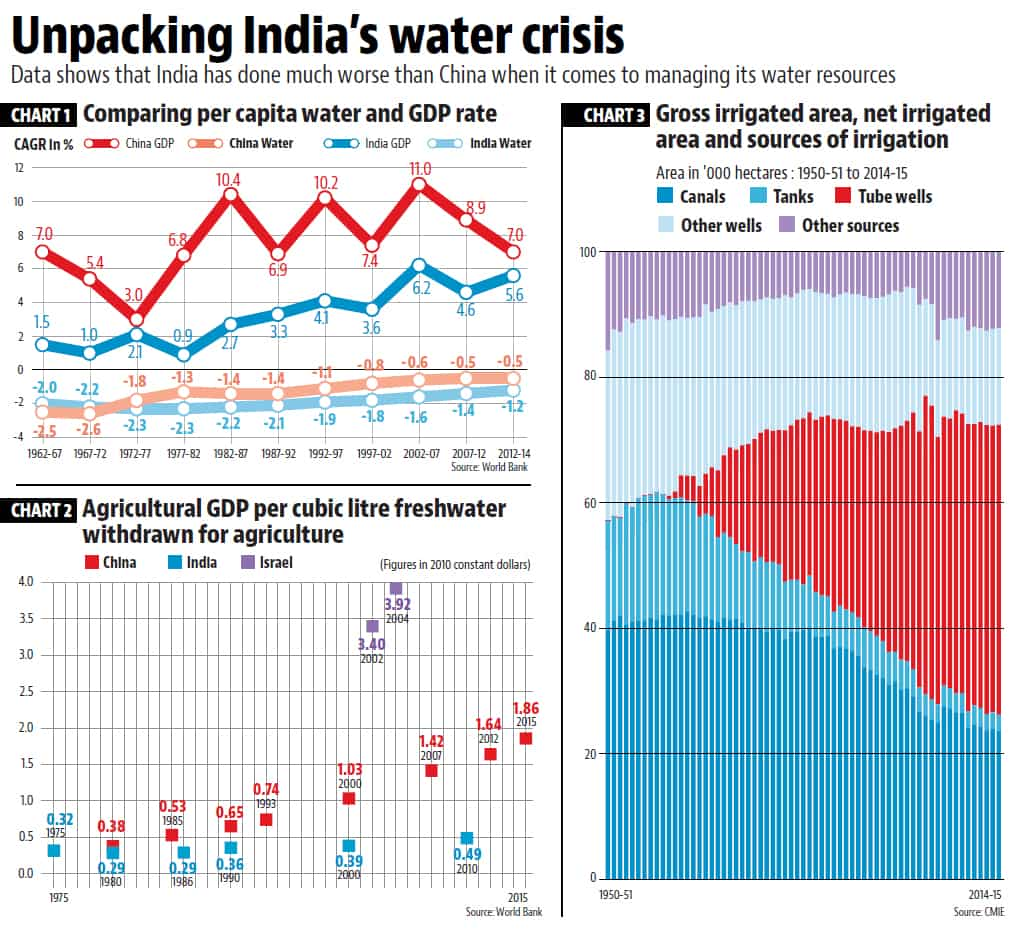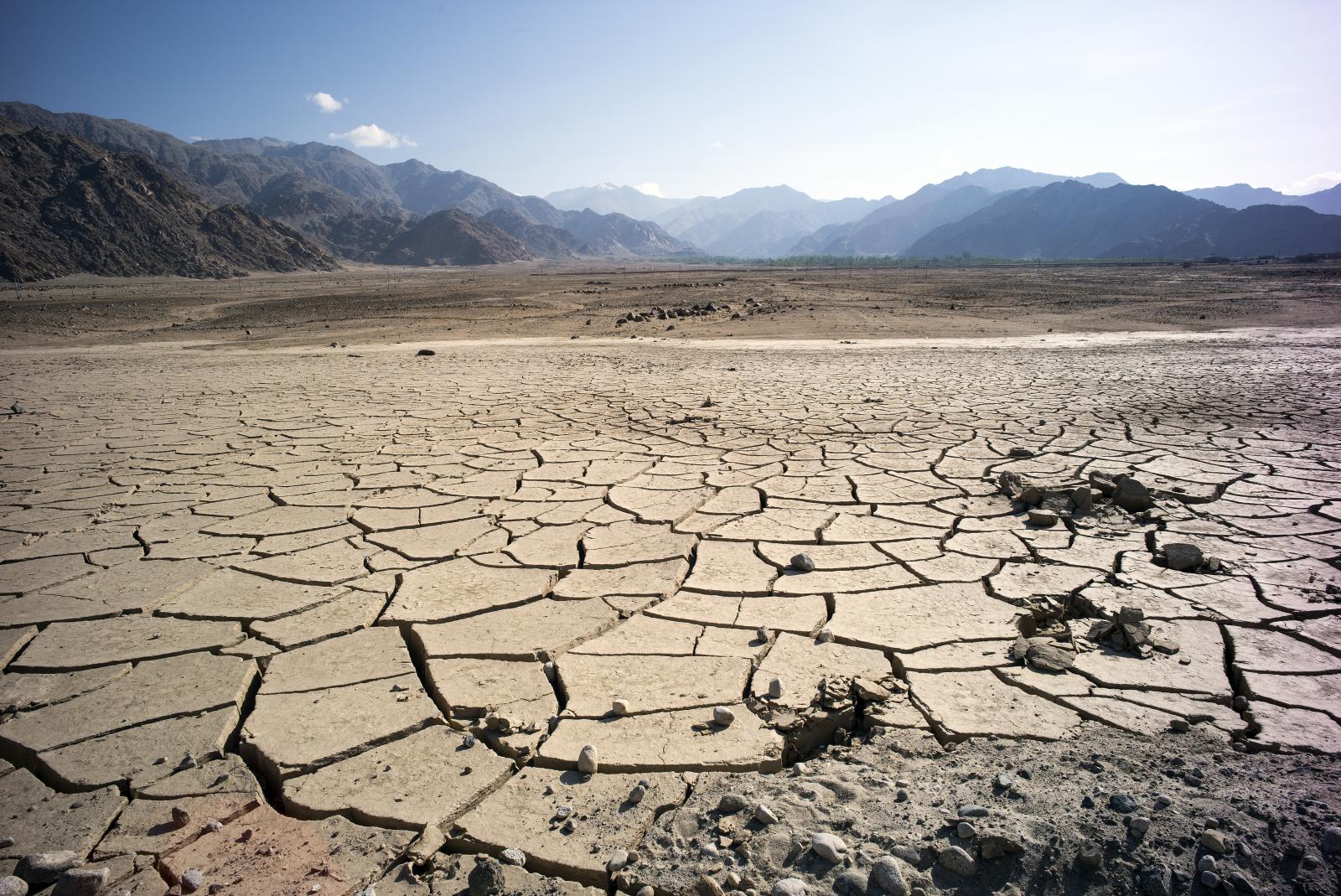In 2010, Aurangabad district in Maharashtra grabbed the headlines when it made the record books for placing the biggest bulk order for Mercedes Benz luxury cars; 65 cars worth ₹150 crore were bought in one go. Today, this district is witnessing a booming demand for a completely different kind of product: water tankers. A Hindustan Times story by How India Lives shows that the demand for water tankers between the first week of May and the third week of June in Aurangabad doubled, from 3,934 to 7,830, between 2018 and 2019. Aurangabad had the highest orders for tankers among all districts in Maharashtra (excluding Mumbai) both 2018 and 2019. The story of Aurangabad, where rising private wealth and a deepening ecological crisis have gone hand in hand, is symptomatic of the larger Indian growth story.
The conflict between economic growth and environmental destruction, of which water scarcity is now an important aspect, is often seen as a given. However, India has done much worse on this front than others.
A comparison with China using World Bank statistics proves this point. In 1962, India’s per capita GDP (in 2010 constant dollars) was almost twice that of China. India’s renewable internal freshwater resources per capita (henceforth per capita water), measured in cubic metres, was 75% of what it was for China in 1962. By 2014, the latest period for which water statistics are available, India’s per capita water had become 54% of what it was for China, even as China’s 2014 per capita GDP became 3.7 times that of India.

Related article: P Sainath: The water crisis is not caused by drought
To be sure, the statistics quoted above also show that the rate of decline in India’s per capita water has been slowing down over the years. The compound annual decline rate in India’s per capita water was more than 2% until the 1980s. It has improved to 1.2% between 2012 and 2014. Even here, China has been able to do even better.
The conflict between economic growth and environmental destruction, of which water scarcity is now an important aspect, is often seen as a given. However, India has done much worse on this front than others.
It has managed to restrain its decline of per capita water to under 1% (compound decline rates, again) from the beginning of the century. And it achieved this at much higher rates of per capita GDP growth than what India has even today.
What explains this mismatch between economic growth and water utilisation between the two countries? The answer is a bit counter-intuitive. Normally, it is water crisis in urban areas which grabs our attention. However, an overwhelming share of water consumption in India and other countries is in the agriculture sector. For example, 90% of India’s freshwater withdrawals in 2010, the latest year for which data is available, were for agricultural use. Even in China, where the share of agriculture in GDP is almost half of what it is in India, 64% of total water freshwater use was on account of agriculture.
As is to be expected, the pace of depletion of a country’s water resources is dependent to a large extent on the water efficiency of its agricultural production. A water-inefficient agriculture sector is the main reason for the growing crisis on the water front in India.
A simple calculation can illustrate this point. World Bank statistics allow us to calculate agricultural output per litre of freshwater withdrawal for a country. In 2010, India produced 0.5 dollars (at 2010 prices) of agricultural GDP for a litre of freshwater withdrawal for agriculture purposes.
This figure was 1.4 and 1.6 for China in 2007 and 2012. For Israel, a country which is often seen as a success story in rationalising water use, this value was 3.9 in 2004 itself. What is most disconcerting is that India has seen virtually no increase in its agricultural output per unit of water use in the last three decades.
A lot of the water inefficiency in Indian agriculture can be explained by the rapid expansion of tube well based irrigation in the last three decades. In 1960-61, tube well based irrigated area had a share of 0.5% in India’s gross irrigated area. This increased to 10% by 1969-70, and stood at around 33% in 2014-15, the latest year for which data is available.
A water-inefficient agriculture sector is the main reason for the growing crisis on the water front in India.
The proliferation of tube well based irrigation has also caused more damage on at least two more fronts in addition to depletion of ground water tables. One, it has allowed farmers to cultivate crops which could have been otherwise unviable in given agro-climatic conditions. This has led to problems such as increasing soil salinity etc, which have jeopardized the long-term sustainability of farming practices itself.
Also, because farmers often use subsidized electricity to run their pumps, most state electricity distribution boards run huge losses, adding to the fiscal deficit of state governments. To be sure, tube well based irrigation was an important pillar of India’s green revolution success story in food grain production.

Photo Courtesy: Wikimedia Commons
A two-part data series by this author published in the Mint newspaper in 2016 dealt with the issue of water inefficiency of India’s agricultural sector in detail. It used data from Water Footprint Network, a global network on water issues, to show that most Indian states used more water than global averages to grow important crops such as wheat, rice, cotton, sugarcane and maize. What was even worse was the fact that a significant part of India’s water intensive agricultural production was actually exported, amounting to a virtual export of water, as one of those articles pointed out. That article also pointed out that most of India was already facing a severe water crisis, seen from the fact that many river basins were facing a severe to significant water stress, defined as the ratio of total water use and availability, in most months of the year.
Related article: The politics of groundwater
As is obvious from the discussion above, India’s water crisis is not a new phenomenon. However, things might have become worse this year. Even though the monsoon has officially arrived in large parts of the country, there is a significant rainfall deficit so far. Cumulative rainfall in 2019 in the week ending 26 June, 2019 was 36% less than the long period average (LPA). This deficit was just 9% of the LPA in the same week in 2018.
Lack of rains this year, at least as of now, have triggered a big water crisis in many parts of the country. From parched villages in Maharashtra to big cities such as Chennai, even securing drinking water has become a challenge for a large number of people.
The centrality of agriculture in India’s water crisis notwithstanding, problems on other fronts cannot be ignored.
According to the fourth National Family and Health Survey conducted in 2015-16, potable water is still a luxury for most Indians. Only 30% of the country’s population had drinking water piped into their dwellings. In rural areas, this value was not even 20%. 51% of rural households used a tube well or bore well to get their drinking water, the survey showed.
India’s water crisis is not a new phenomenon. However, things might have become worse this year.
What complicates matters even more is that people often do not trust, which could or could not be based on actual experience, potable water supplied to their houses as being fit for human consumption. This can lead to further wastage of water.
The rapid growth in sale of reverse osmosis (RO) water filters — most relatively well-off households use one probably – is a direct result of this. The input to output water use ratio for a typical RO filter is around four. The residual water from RO filters is often wasted due to lack of institutional arrangements to use it for other purposes. Had households in India trusted their supply source for human consumption, which is the norm in developed countries, our drinking water consumption could have come down significantly.
Private efforts to secure water by sources such as tube wells and RO filters are a reflection of the Indian state’s failure to develop a functional and credible public distribution network for water. The fact that suburbs such as Gurugram and Noida, and many others cities in the country, have been allowed to come up and grow rapidly without any plan for community water supply, and are mostly reliant on groundwater, suggests that we have been adding to our water woes rather than solving them. That water governance and sustainability concerns were given a go by even while accommodating the relatively well off in India’s new cities, where people would have been in a better position to pay for such facilities, explains the difficulty of rationalising water usage by India’s farmers, who are perpetually crisis ridden. It is extremely difficult to imagine any political party forcing farmers to abandon their tube wells and invest significant amount of money into more water-efficient farming practices. To be sure, some of such changes would also require a behavioural change rather than just money.
The results of such negligence are already beginning to manifest themselves. A Niti Aayog study published in 2018 projects India’s water demand to be twice the supply by 2030, which will create a severe water scarcity and economic loss. Unless immediate and drastic measures are put into place to prevent matters from getting even worse, this crisis will only become bigger in the days to come.
This article was originally published on Hindustan Times.





